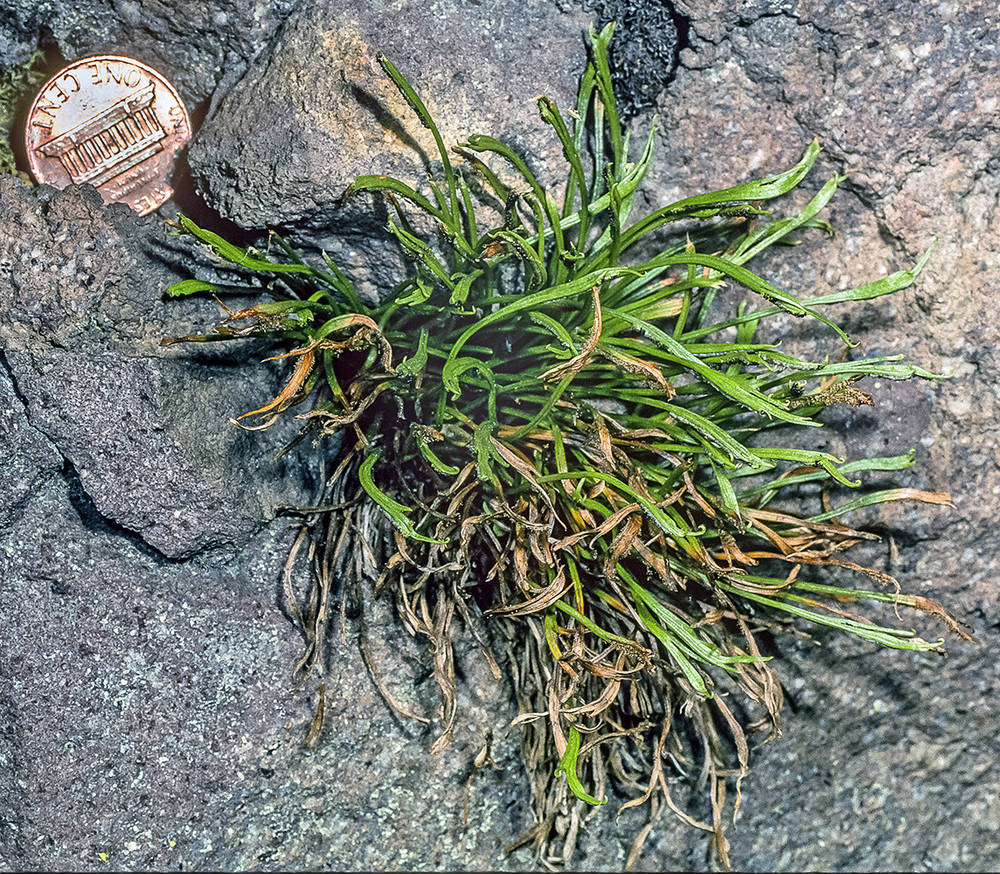
Stems thick, ascending or shortly creeping in rock crevices, usually unbranched, densely covered with non-bicolored, long (approximately 5 mm) lattice-like scales and long persistent leaf bases.
Leaves graminoid, forked, evergreen, or at least overwintering, often numerous in a dense cluster along the stem, 3–10 cm long; petioles, rachises and blades poorly differentiated.
Petioles glossy yellow-brown basally with sparse narrow scales, green and flattened and glabrous distally, rachises (above the first fork, if present) green and flattened.
Blades linear, forked, branched up to 3 times more or less dichotomously or irregularly.
Pinnae 1–2 mm wide, linear, elliptic to spathulate, often with a few small tooth-like lobes.
Sori elongate, 1 to several on the abaxial surface, parallel to the midrib, often poorly delineated and anastomosing when mature; indusia present, pale, attached along veins and partially covering the sori on 1 side.
2n=144.
Exposed or shady rocky crevices. 400–1700 m. Casc. CA; scattered locations in western US and WV; Africa, Eurasia. Native.
as described under Asplenium septentrionale
Roots not proliferous. Stems erect, much branched to produce dense many-stemmed tufts or mats bearing numerous crowded leaves; scales dark reddish brown to black throughout, narrowly deltate, 2--4 × 0.3--0.6 mm, margins entire. Leaves monomorphic. Petiole dark reddish brown proximally, fading to green distally, 2--13 cm, 2--5 times length of blade; indument absent. Blade linear, simple or more often 1-pinnate, 0.5--4 × 0.1--0.4 cm, occasionally wider when pinnae strongly diverge, leathery, glabrous; base acute; apex acute, not rooting at tip. Rachis green, lustrous, glabrous. Pinnae of pinnate leaves 2(--4), strongly ascending to give forked appearance, linear, (5--)10--30 × 0.75--3 mm; base acute; margins remotely lacerate; apex acute. Veins free, obscure. Sori usually 2+ per pinna, parallel to margins. Spores 64 per sporangium. 2 n = 144.Cliffs of various substrates; 700--2900 m; Ariz., Calif., Colo., D.C., N.Mex., Okla., Oreg., S.Dak., Tex., Utah, W.Va., Wyo.; Mexico in Baja California; Europe; Asia.In North America Asplenium septentrionale is principally a western species with isolated disjunct populations in Monroe and Hardy counties, West Virginia. Because of its close resemblance to a tuft of grass, it is easily overlooked, and discoveries of additional localities are to be expected. In Europe A . septentrionale is known to hybridize with several species, but in North America only the hybrid with A . trichomanes ( A . × alternifolium Wulfen) is known.